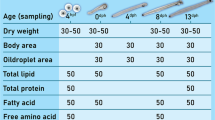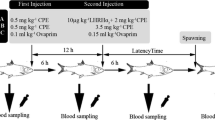Abstract
Weekly injections of salmon pituitary extracts (SPE) were administered to female Japanese eel, Anguilla japonica at a dose of 20 mg/fish. This induced vitellogenesis and caused oocytes to reach the migratory nucleus stage. Later, a majority of the females that received an injection of SPE at a priming dose, followed 24 h later by 17,20β-dihydroxy-4-pregnen-3-one (DHP), ovulated 15 to 18 h after the final injection. In cultivated males, repeated injections of human chorionic gonadotropin (hCG) at a dose of 1 IU/g BW/week induced spermatogenesis and spermiation. Since potassium ions were revealed to be an essential constituent for the maintenance of motility in the eel spermatozoa, artificial seminal plasma containing KCl was designed as a diluent of milt, and enabled the preservation of milt for several weeks in refrigeration. As a result, artificial fertilization performed immediately after ovulation with pre-diluted and stocked milt consistently resulted in the production of high-quality gametes. Recently, a slurry-type diet made from shark egg yolk has been found to be a suitable feed for captive-bred eel larvae. Although preleptocephalus larvae can be reared with this diet beyond the depletion of their yolk and oil droplet stores, it remains inadequate because larvae reared under this way cannot be raised to the following stage. Therefore, the diet was improved by supplements of krill hydrolysate, soybean peptide, vitamins and minerals. Larvae fed on this new diet have grown to 50 to 60 mm in total length (TL), and have begun to metamorphose into glass eels approximately 250 days after hatching.
Similar content being viewed by others
References
Kagawa, H., Iinuma, N., Tanaka, H., Ohta, H. and Okuzawa, K. 1998. Effect of rearing period in seawater on induced maturation in female Japanese eel Anguilla japonica. Fish. Sci. 64: 77–82.
Kagawa, H., Tanaka, H., Ohta, H., Okuzawa, K. and Iinuma, N. 1997. Induced ovulation by injection of 17,20β-dihydroxy-4-pregnen-3-one in the artificially matured Japanese eel, with special reference to ovulation time. Fish. Sci. 63: 365–367.
Kurokawa, H., Kagawa, H., Ohta, H., Tanaka, H., Okuzawa, K. and Hirose, K. 1995. Development of digestive organs and feeding ability in larvae of Japanese eel (Anguilla japonica). Can. J. Fishe. Aquat. Sci. 52: 1030–1036.
Lokman, P.M. and Young, G. 2000. Induced spawning and early ontogeny of New Zealand freshwater eels (Anguilla dieffenbachii and A. australis). N. Z. J. Mar. Freshwat. Res. 34: 135–145.
Ohta, H. and Izawa, T. 1996. Diluent for cool storage of the Japanese eel (Anguilla japonica) spermatozoa. Aquaculture 142: 107–118.
Ohta, H., Kagawa, H., Tanaka, H., Okuzawa, K. and Hirose, K. 1996a. Changes in fertilization and hatching rates with time after ovulation induced by 17, 20β-dihydroxy-4-pregnen-3-one in the Japanese eel, Anguilla japonica. Aquaculture 139: 291–301.
Ohta, H., Kagawa, H. Tanaka, H., Okuzawa, K. and Hirose, K. 1996b. Milt production in the Japanese eel Anguilla japonica induced by repeated injections of human chorionic gonadotropin. Fish. Sci. 62: 44–49.
Ohta, H., Kagawa, H., Tanaka, H., Okuzawa, K., Iinuma, N. and Hirose, K. 1997. Artificial induction of maturation and fertilization in the Japanese eel, Anguilla japonica. Fish Physiol. Biochem. 17: 163–169.
Prokhorchik, G.A. 1986. Postembryonic development of European eel, Anguilla anguilla, under experimental conditions. J. Ichthyol. 26: 121–127.
Satoh, H. 1979. Try for perfect culture of the Japanese eel. Iden 33: 23–30 (in Japanese).
Tanaka, H., Kagawa, H., Ohta, H., Okuzawa, K. and Hirose, K. 1995. The first report of eel larvae ingesting rotifers. Fish. Sci. 61: 171–172.
Tanaka, H., Kagawa, H. and Ohta, H. 2001. Production of leptocephali of Japanese eel (Anguilla japonica) in captivity. Aquaculture 201: 51–60.
Tsukamoto, K., Lee, T.W. and Mochioka, N. 1994. Age and growth of Japanese eel leptocephali. In: Otake, T., Tsukamoto, K. (Eds.), Preliminary Report of the Hakuho Maru Cruise KH-91-4. Ocean Research Institute, University of Tokyo, Tokyo, pp. 50–54.
Wang, Y., Zhao, C. Shin, Z., Ten, Y., Zhang, K., Li, Y., Yang, Y. and Hong, Y. 1980. Studies on the artificial inducement of reproduction in common eel. J. Fish. China. 4: 147–158 (in Chinese, with English abstract).
Yamamoto, K. and Yamauchi, K. 1974. Sexual maturation of Japanese eel and production of eel larvae in the aquarium. Nature 251: 220–222.
Yamauchi, K., Nakamura, M., Takahashi, H. and Takano, K. 1976. Cultivation of larvae of Japanese eel. Nature 263: 412.
Yamauchi, K. and K. Yamamoto 1982. Experiments on artificial maturation and fertilization of the Japanese eel (Angulla japonica). In: Reproductive Physiology of Fish (ed. By C.J. Richter and G.J.Th. Goos), Pudoc Press, Wargeningen, pp. 185–189.
Author information
Authors and Affiliations
Rights and permissions
About this article
Cite this article
Tanaka, H., Kagawa, H., Ohta, H. et al. The first production of glass eel in captivity: fish reproductive physiology facilitates great progress in aquaculture. Fish Physiology and Biochemistry 28, 493–497 (2003). https://doi.org/10.1023/B:FISH.0000030638.56031.ed
Issue Date:
DOI: https://doi.org/10.1023/B:FISH.0000030638.56031.ed




